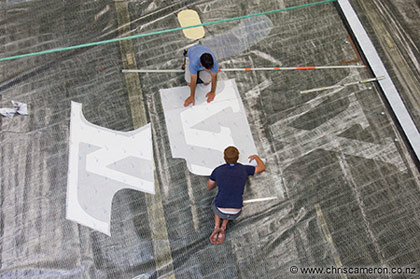|
Related: Read the BMW Oracle side of the story here Auckland, February 4, 2009
One of the first people Grant Dalton needed to talk to get the Louis Vuitton Pacific Series underway was Andy Nottage, Emirates Team New Zealand's Shore Team Manager. ETNZ's 2007 generation boats were not remotely ready for international match racing. In fact they were in pieces. “The boats were fully stripped, the bulbs and fins taken apart,” said Nottage, and, as with the BMW Oracle boats, all gear pulled from the hulls. “Even the electrical wires were taken off, so we had to start from scratch. We had 10 guys to begin with, but now we’re 20 dedicated guys, including chase boat drivers and volunteers.” Bringing the boats back to life had an extra complication in the LVPS, namely how to get the appendages as similar as possible. This was no simple task since ETNZ’s keels don’t resemble each other, purposely designed to be different, but a timely solution was possible due to the Kiwi team’s intimate knowledge of their 2007 designs. “The designers gave us a format of what they wanted -- which fin with which bulb, which rudder, the wings at what angle -- and we put them together,” said Nottage. More than 1000 man-hours later, NZL-84 and NZL-92 are racing again. Though BMW Oracle and ETNZ both lent their boats for the regatta, the two teams have worked solely on their own boats. Both pairs are equalized to themselves, not to the other team’s yachts. A Team New Zealand boat won’t be sailing against a BMW Oracle boat.
Once the teams arrived in Auckland for a week of practice prior to the event, ETNZ sailors gave an orientation to five members from each of the teams, giving them a tour of the boats so they could go through the boat and learn the systems. During the first two days of sailing a Team New Zealand representative also sailed onboard each boat. Aside from adapting the boats to race against each other, the other consideration was how to prepare them to be match-raced by a rotation of sailors who were either unfamiliar with these particular yachts, or, in some cases, inexperienced with any Cup-type yachts at all. “These are guys who don’t know how to sail these particular boats, just like it was hard for our guys to jump on the Oracle boats the first day, because they’re so different.” Nottage and his crew first focused on making things a little easier for teams who were not accustomed to all the bells and whistles the New Zealanders enjoyed onboard in 2007. “The boats were actually quite hard to simplify because they are what they are, but we did our best. For example we add an extra winch in the pit on both boats because we were very conscious of wind in Valencia, so we had very small winches in the pit.” Adding the winch for Auckland wasn’t just a bolt-in proposition. “That was also one of the bigger expenses and time-consuming parts, since we had to do some carbon work,” Nottage said. “We also simplified some things, like the string-line system. We restricted jumpers so they don’t move, and re-arranged the way the main traveler works,” he added. “We also didn’t put on all the sensors. We just kept the important ones, like one on the runner gauge. We put a buzzer on it, so if someone gets to a certain amount of rod tension then the buzzer goes off to tell them they’ve gone too far.” The final piece of the puzzle is keeping the yachts ready for action. The end of each race day always brings a checklist filled with repairs and service. There may not be major damage, but there’s always something new.
“There are little things every night: re-attach a tool bag that needs to be glued on, grease on the rudder,” says Nottage. As for the layday, he says it is “all about area checks, just to see if there are some preventative things we can do. It’s all about that, really. “All the ropes need changing because they don’t have much life and they’re really getting worked. And these winches need to be serviced all the time, so it’s a chance to catch up on that.” The last Nottage should know well, he formerly was shore crew winch specialist. “I’m running three boat builders on night shift and they’ve pretty much been going from 3 pm to 1-2 am every day.” Day One of the regatta brought the first collision. The new team, Greek Challenge, got a little too close to Alinghi in the pre-start, hitting them hard enough to draw a hard contact penalty. Nottage was happy that the collision turned out to be relatively little in the way of damage. “It was fairly minor, just a small piece out of the front of the bow so it was very easy. Just cut it out, put some foam on, re-laminate over the top of it, and paint it. The worse one is always going to be if we have a T-bone or a rig down or a rudder break -- we only have one spare rudder.” Most serious so far was the repair of a headfoil on Day 3. When Shosholoza came onboard NZL-92 and could not raise the jib, the boat returned to base in hopes of repair. It was “all hands on deck” quite literally with ten shore crew working hard to avoid disrupting the event schedule. Repairs to the boats have been pretty straightforward so far, said Nottage, though he also observed “You never know when there’s going to be a big one around the corner.”
-- Reporting by Diane Swintal for CupInfo/©2009 CupInfo Links of Interest:
Also see: Visit the Official LVPS Web Site |


